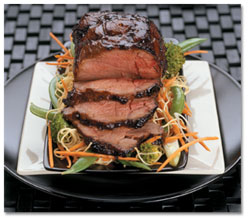Why Grain-fed?
Demand for Le Québécois Grain-fed Veal is soaring nationwide. Here's why!
Robust Flavor

A diet that includes grain increases the flavor of veal for two reasons.
First, grains give the meat subtle marbling that infuses the entire cut
with flavor, while maintaining the tenderness that veal is known
for. Second, grain-fed veal contains more iron and other minerals.
What this means is that Le Québécois grain-fed veal has great flavor
that stands on its own and doesn’t have to be heavily sauced like
pale veal.
It’s a win-win because you can serve tastier meat and keep
your food costs down by using less sauce.
Rose-colored AND More Tender
Forget the myth, created by a successful marketing campaign in the 70s, that veal has to be pale to be tender. Before that, all veal was rose-colored because it naturally had iron in its diet. Color has NOTHING to do with tenderness. It just means that there’s iron in the meat, which is a good thing.
Very Stable Prices
Le Québécois market prices are extremely stable. The Canadian grain-fed veal market is somewhat insulated from veal commodity market fluctuations, principally because grain-fed veal growers are unified and believe that price stability leads to long-term market expansion.
Opportunity for Greater Margins
Le Québécois prices are highly competitive and the grain-fed veal market is stable. This leaves plenty of room for greater margins.
Consistent Cut Sizes & Grading
Le Québécois grain-fed veal processors select only the finest grades and cuts to be sold under the Le Québécois brand in the United States.
Attributes to Satisfy the Growing Health Food Segment
Humane treatment… No added hormones or antibiotics… Natural diet… Environmentally sustainable farming practices…
The Natural Color of Veal
Conventional wisdom holds that pale veal is the finest veal in terms of flavor and tenderness. Conventional wisdom is wrong.
When we launched Le Québécois Grain-fed veal in 2000, we strongly felt (especially after blind tastings) that the importance of meat color was a myth. We admit that we were faced with skepticism from chefs accustomed to pale meat. And, although a majority of chefs no longer believe the myth, some skeptics remain.
As we and thousands of chefs have learned, veal color is in fact very important, but for different reasons than popular myths would have us believe. We discovered that the rose veal color is the result of an iron-rich and nutritious diet of grains and milk. While this diet allows the natural color of veal to shine through, it also gives it a more robust flavor. Plus, the grain gives the meat subtle marbling that infuses the meat with tenderness. And, since grain-fed calves do not need preventative antibiotics to stay healthy, the meat always has a clear flavor profile.
Thousands of fine restaurants in nearly every state have Le Québécois Grain-fed Veal on their menus. Those chefs (and, their numbers are increasing) know that it is just as delicate, and plates the same, as conventional veal, in addition to having a complex, delicious flavor profile.

